Abstract
A major challenge for the oil and gas industry is expediting the exploration geophysics activity. It is necessary to produce fast and accurate image of the targeted hydrocarbon reservoir, yet it involves extensive dataset due to the target location lies in deeper subsurface. Therefore, target-oriented oil and gas-reservoir imaging is currently seen as more attractive than conventional full-volume migration, in terms of computation efficiency. Through the integration of seismic redatuming with Kirchhoff migration, we presented a target-oriented imaging workflow that can effectively reduce computational cost while simultaneously enhancing the accuracy of the migrated image. Kirchhoff migration is renowned for being one of the simplest and flexible migration techniques, making it straightforward to implement. However, this migration approach is typically avoided in the presence of complex geology, as it tends to introduce artifacts in the images, thereby disrupting the interpretation beneath the complex overburden. Therefore, this paper highlighted the advantages of utilizing seismic redatuming to retrieve data beneath the overburden, followed by the utilization of the redatumed data as input for Kirchhoff migration. With an improved signal to noise ratio, the primary reflection events were amplified, providing clearer representation of the subsurface structure within the hydrocarbon reservoir or targeted area. Additionally, we utilized the benefits of Kirchhoff migration and explored the feasibility of performing patch-based migration in several areas of interest beneath the salt layer. This approach aimed to reduce both the turnaround time and the associated seismic migration costs. The developed workflow then was subsequently put to the test and applied to both a sub-salt SEG Advanced Modeling (SEAM) model and field data situated in East Malaysia. Based on the outcomes of the target-oriented migration, the proposed methodology demonstrated its capability to generate better quality and instant migrated images within the designated region. Furthermore, the feasibility of target-oriented imaging with Kirchhoff migration was substantiated through the integration of seismic redatuming, resulting in significant benefits towards seismic processing, imaging, and interpretation.
1. Introduction
Despite the existence of various advanced seismic migration approaches, pre-stack depth migration continues to hold its position as the most widely implemented technique. The challenges associated with this method and potential solutions are still subjects of ongoing discussion [1,2]. Indeed, pre-stack depth migration holds particular importance, especially when confronted with lateral velocity variations within the overburden section. It has the capability to yield more precise images with an elevated signal-to-noise ratio compared to post-stack migration [3,4,5,6]. Consequently, it is proven advantageous for performing amplitude versus offset (AVO) analysis [6,7,8,9], facilitating fluid identification, and hydrocarbon reservoir characterization. Nonetheless, despite the growth in computing power, performing a full-scale 3D pre-stack depth migration remains challenging due to the extensive processing time and substantial demand on computing memory and storage. Thus, in an effort to make 3D pre-stack depth migration feasible for fast migration, it is essential to implement a target-oriented migration scheme. This approach aims to generate enhanced seismic data that are more manageable to process and capable of illuminating the target area efficiently, even beneath complex overburden conditions during the exploration geophysics activity.
Ideally, 3D target-oriented pre-stack depth migration involves the calculation of reflectivity images exclusively for the identified target zones, aligning with the study’s objectives and focusing on the specific area of interest. This target-oriented imaging approach leads to a reduction in the turnaround time required for 3D seismic imaging [10,11,12]. The concept has been a subject of discussion in the literature since the 1990s and gained further traction in the 2000s, as researchers began seeking solutions to address the computational demands of 3D seismic imaging. Nevertheless, the full potential of target-oriented imaging has not been fully exploited thus far.
In 2003, Jiang and Schuster [13] presented their findings on a target-oriented version of least-squares migration (LSM) using Kirchhoff migration. In order to reduce computational costs in LSM, they identified the target area and executed LSM solely within a smaller subset of the data. However, a concern emerged because the proposed scheme did not incorporate the overburden effect, consequently impacting the precision of the migrated image. Furthermore, they exclusively evaluated the target-oriented least-squares migration scheme using post-stack datasets. Later, as Reverse Time Migration (RTM) made significant advancements in seismic processing and imaging, Luo, and Schuster (2004) [14] introduced reverse time datuming to address the computational costs associated with acquiring RTM images. This concept was later implemented on 3D synthetic data by Dong et al. (2007) [15]. Even so, people’s perception remains that computing RTM demands significant computational cost. The latest study conducted by Zhang et al. (2018) [16] showcased the benefits of Gaussian beam migration to fulfill the demands of target-oriented imaging through the application of a modified ray-tracing scheme. Even though they successfully formulated a target-oriented imaging algorithm, the proposed method still required a huge number of computations due to the ray calculations. In a different application of target-oriented imaging, the patched Green’s function (PGF) technique was used by Barbosa et al. (2022) [17] to reduce the computational cost of imaging problems based on wave equation. Indeed, this indicates that research on target-oriented imaging is still in progress, with ongoing efforts to identify appropriate solutions for effectively imaging the target area.
In this paper, we delved into the Kirchhoff migration method for implementing target-oriented imaging. This method might be the oldest migration technique and possesses the simplest approximation for accurate seismic imaging. Despite that, it is recognized as the optimal approach for pre-stack migration and continues to be utilized to date, particularly within the framework of least-squares migration [18,19,20,21,22]. The continued relevance of Kirchhoff migration stems from its algorithmic flexibility. First, it allows Kirchhoff migration to accommodate diverse acquisition geometries and source–receiver configurations. This adaptability makes it well suited for processing various types of seismic data, including land, marine, and borehole data. Secondly, Kirchhoff migration also offers flexibility in defining the imaging conditions. Through modification of the weighting functions employed in the migration process [23,24], it becomes feasible to amplify specific features or attenuate undesired artifacts. Thirdly, owing to its flexible and expedient algorithmic benefits, the Kirchhoff migration method is capable of achieving target-oriented migration [25]. The most straightforward approach involves its direct application in amplitude summation by focusing solely on the hydrocarbon reservoir areas. Nevertheless, this method exhibits reduced accuracy, as it fails to consider the influence of the overburden during the migration process
In fact, the hydrocarbon reservoirs or areas of interest are typically located at greater depths within the subsurface, and the recorded data tend to be distorted during the wave propagation through the overburden, particularly in the presence of complex anomalies such as salt or shallow gas clouds. These distortions are due to the strong lateral variation of the velocity in the overburden which then results in strong scattering effects, dispersion, internal multiples, and mode conversion as well as anelastic losses [26]. This is precisely why the Kirchhoff migration approach is typically avoided in the presence of complex geology, as it tends to introduce artifacts in the images, thereby disrupting the interpretation beneath the complex overburden. The distortions are observed as diffractions, discontinuities, or undulations in the seismic record; thus, neglecting these effects may leads to inaccurate analysis for hydrocarbon reservoir imaging or characterization.
Therewith, seismic redatuming is used to simplify the recorded data and eliminate the overburden effects [26,27] by virtually relocating the acquisition surface beneath the complex geology, simulating the acquisition as if it were conducted at the redatumed level [28]. A seismic redatuming method was primarily used as a straightforward static correction, mainly applied on land seismic data, However, it has emerged as part of subsurface imaging to addressed challenges associated with the complex near surface conditions. The advantages of seismic redatuming have been increasingly acknowledged for achieving enhanced imaging and velocity model building compared to standard data processing [29]. Even with the existence of various redatuming methods, such as Wavefield Redatuming [30,31,32], and Marchenko redatuming [33,34,35,36], the fundamental principle remains consistent: dividing the subsurface into two distinct zones—the overburden and the target area. Then, the correction of transmission effects within the overburden is accomplished by employing a specific redatuming method to derive redatumed data.
Recent literature highlights the extensive utilization of seismic redatuming advantages in the context of target-oriented velocity model building. Recognizing that the velocity model building process is exceedingly time-consuming within seismic processing and imaging procedures, seismic redatuming is employed to effectively decrease the overall time required for generating precise velocity models. For example, it has found applications in time-lapse Full Waveform Inversion [37,38], datum-based Full Waveform Inversion [39,40], and target-oriented elastic Full Waveform Inversion [41,42,43].
Meanwhile, in this study, we explored the potential application of seismic redatuming for target-oriented imaging, with proper incorporation of the overburden effect to image the targeted area or the region below complex overburden. We developed an optimal workflow for target-oriented imaging through the combination of seismic redatuming with Kirchhoff migration. The objective was to establish an efficient migration process while ensuring a satisfactory level of accuracy. We applied the proposed workflow to both synthetic and field seismic datasets, evaluating its advantages and limitations, while also discussing potential future research.
2. Methodology
2.1. Target-Oriented Kirchhoff Migration
Theoretical assumptions assume that each point within the subsurface functions as a scattering point. Waves propagate from the source point, travel downward to the subsurface point, and, subsequently, propagate back to the receiver point. Consequently, we can say that the wavefield recorded at the receivers are coming from every scatter point in the subsurface. However, the recorded events are often not directly coming from reflector beneath the receivers; instead, they might come from geological formations situated away from the point of recording. Hence, the needs of seismic migration to accurately relocate the recorded events to their correct spatial position within the subsurface. Seismic migration can be performed either before (pre-stack) or after stacking (post-stack).
Kirchhoff migration is acknowledged as one of the most effective methods for pre-stack migration and is widely employed within the industry [44]. This is because of its algorithmic versatility, which permits its application in both 2D and 3D data for pre-stack or post-stack processing, whether in the time or depth domains. Additionally, the Kirchhoff migration algorithm is capable of handling steep dips [29,44,45,46], adapting to irregular sampling [19,47], accommodating lateral and vertical velocity variations [48], and, most importantly, delivering dependable results while maintaining efficiency [2,49]. However, Kirchhoff images provide less accuracy and suffer with migration artifacts compared to other migration methods, especially with complex and challenging structural-imaging problems [29,46,49].
Kirchhoff migration was originally introduced by Schneider in 1978 [50] building upon the migration algorithm framework established by Hagedoorn (1954) [51]. Kirchhoff migration employs the Huygens principle as its foundation, involving the summation of amplitudes over diffraction hyperbolas and assigning the resultant summed amplitude to the apex. Mathematically, the Kirchhoff migration process is expressed as an integration over the recorded data, involving Kirchhoff summation conducted in both the source and receiver dimension. Let U, the wavefield recorded at the receiver location, the image of the subsurface, at location (for 2D) with time is represented by:
where A is the migration aperture, W is the weight function, , are the coordinates of source and receiver, respectively, and is the total traveltime from source to scatter point and from scatter point to receiver.
In this study, we implemented target-oriented Kirchhoff migration by combining seismic redatuming with Kirchhoff migration. The Kirchhoff summation will be carried out only at the target area below the specified datum level. Figure 1 shows the change of the source and receiver geometry after seismic redatuming when we have the target area smaller than the original area.
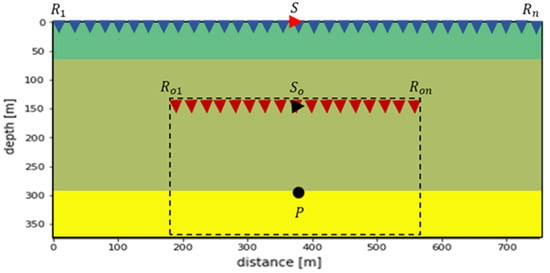
Figure 1.
An illustration displays the transformation of geometry, transitioning from surface acquisition to a redatumed virtual acquisition when the target area is smaller. It is important to note that due to changes in the source and receiver geometry and size, the migration aperture size also undergoes alteration.
A crucial aspect to consider when working with seismic redatuming is the aperture. It is important to recognize that the aperture of the redatumed data can indeed differ from that of the original surface data. This is because the redatuming process involves changing the geometry of the acquisition surfaces. Depending on the specific approach adopted for redatuming and the imaging objectives, adjustments to the aperture may be made to optimize the imaging outcomes for the desired target depth or location.
Hence, due to this, it subsequently changed Equation (1) to become target-oriented where the image point is now known as :
The coordinate of is still at because we are referring to same image point. Since the position of source and receiver is altered nearer to the image point which represented by , , the time is also changed to , for total traveltime and for the aperture for target-oriented area. Now, the wavefield corresponds to the redatumed data, denoted as , which is retrieved through seismic redatuming method.
As for the implementation of target-oriented imaging, the proposed workflow is illustrated as in Figure 2. The idea is to develop a reliable and efficient migration approach that specifically focusing on reservoir level or targeted areas, while concurrently achieving a migrated image quality that is at least equivalent. The work conducted in this study pertains to the 2D scenario, yet it can be seamlessly extended to 3D implementation. Overall, the aim is to reduce the total computational costs with 3D pre-stack depth migration, rendering it more practical and advantageous in practice.
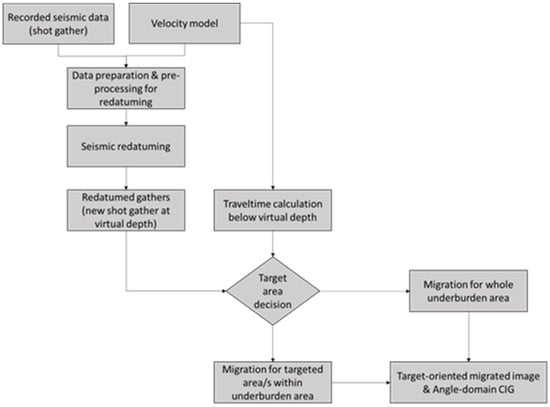
Figure 2.
The proposed workflow for target-oriented seismic migration, combing the seismic redatuming with Kirchhoff migration for better target-oriented imaging. This study only focused on the kinematic correction of the target-oriented migrated image while the angle-domain CIG will be used in the next study related to dynamic correction.
The first step involved establishing the virtual depth of the target area. The region above this virtual depth, often referred to as the datum, is termed the overburden area, while the region below is referred to as the underlying area. Next, the process involves retrieving the redatumed shot gathers from the initially recorded shot gathers through the application of seismic redatuming. For this step, any redatuming method can be employed to obtain the redatumed shot gathers, which will then use as input for the migration process.
The subsequent step involved computing the migration for the target area situated below the datum. Despite being recognized for its straightforward algorithm, Kirchhoff migration is said to have expensive computation because of the travel-time calculation. In addition, we used the fast sweeping method [52,53,54,55] for better accuracy of travel-time calculation for Kirchhoff migration. Indeed, conducting full-scale travel-time calculations can undoubtedly be a resource-intensive computation. However, the proposed target-oriented migration approach has the advantage of mitigating the overall computational cost for Kirchhoff migration. Given the smaller size of the target area, there was consequently a reduction in the computation cost required for travel time calculations.
In the final step, we illustrate that there were two approaches available, as shown in Figure 3. One option is to migrate the entire underlying area, while another alternative is to simultaneously migrate several small target areas. Here, we effectively utilized the advantages of Kirchhoff migration for target-oriented imaging. By incorporating target-oriented imaging using seismic redatuming, we effectively addressed the limitations of Kirchhoff migration, particularly in the realm of complex and challenging structural imaging scenarios.
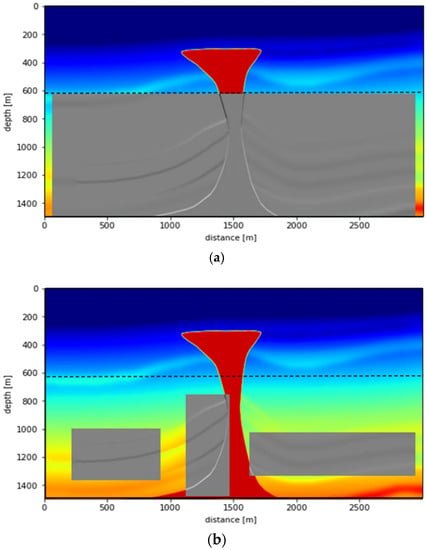
Figure 3.
Target-oriented migration strategies either by (a) migrating the whole area under the virtual depth or by (b) migrating several small areas of interest simultaneously depending on the aim of the migration. Either one still reduced the computational cost compared to full-scale imaging.
In this study, our focus was on the kinematic correction aspect of target-oriented imaging, while the dynamic correction for target-oriented imaging will be addressed in a subsequent study.
2.2. Validation of Redatumed Seismic Data as the Input for Seismic Migration
Within this sub-section, we are presenting the validation process conducted on the redatumed data to confirm their dependability as a reliable input for the seismic migration process. Figure 4 indicates the concept of seismic redatuming, which involves separating the velocity model into segments above and below the datum level. The redatumed data, retrieved from the observed recorded data, basically represent reflections from the subsurface below datum level, as if the sources and receivers were located at datum level. It can be affirmed that the obtained redatumed shot gathers already encompass the effects of the overburden, resulting in an improved signal-to-noise ratio [35,36,43].
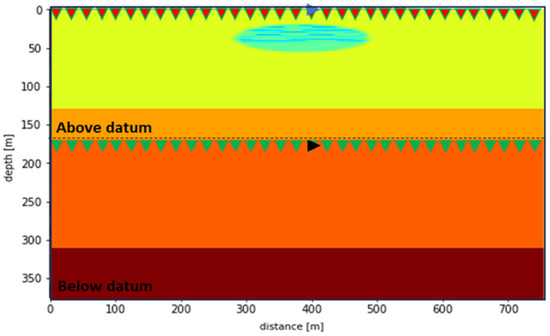
Figure 4.
An illustration shows the model is divided into segments above and below the datum. The original source locations (blue) and receivers (red) are positioned at the surface. These are subsequently virtually shifted to the datum level (indicated by the black dotted line), represented by black (source) and green (receivers) points.
Prior to that, we presented the validation process, which involved a comparison between the quality of the redatumed gather and the observed gather recorded at the surface, as illustrated in Figure 5. First, seismic redatuming was executed using the source and receiver configuration, as shown in Figure 4 at datum level. Then, the redatumed gather obtained for the area below datum was compared with the recorded data at the surface. As shown in Figure 5, it is evident that the primary reflections in the redatumed data exhibited greater visibility compared to those in the surface data. This discrepancy can be attributed to the distortion caused by the salt body in the overburden, affecting the transmission of waves deeper below the datum. Furthermore, it is noticeable that certain internal multiples associated with the intricate overburden have been mitigated. Hence, this serves as the primary purpose for conducting seismic redatuming in which to improve the quality of seismic data below the overburden.
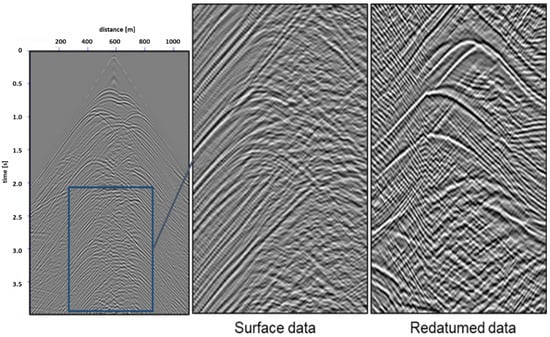
Figure 5.
The seismic gather from the observed recorded data between 2 s and 4 s as highlighted in the box is compared with the redatumed data to showcase the efficiency of redatuming method. Seismic redatuming enhances the signal-to-noise ratio in the data, resulting in the redatumed data exhibiting reduced noise and more distinct reflection events.
Furthermore, we conducted a modeling test to validate the accuracy of the obtained redatumed data. Using the identical source and receiver configuration at the datum level, we performed forward modeling to simulate data below the datum. Subsequently, these modeled data were compared to the previously obtained redatumed data, as shown in Figure 6. A strong correspondence is evident in most primary reflections between the two datasets. Equivalent results were published in [41], where a close agreement was observed between the redatumed data and the data simulated from the datum level. Hence, the reliability of redatumed data for seismic migration has been confirmed.
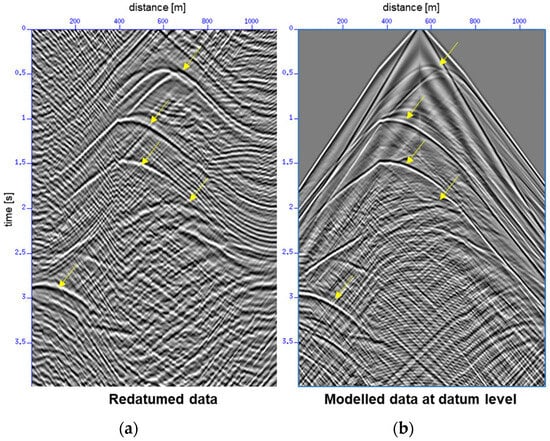
Figure 6.
The shot gathers from (a) redatumed data and (b) modelled data at datum level is compared to validate the accuracy of the redatumed data. The result indicates a strong alignment between the primary reflectors in both datasets as highlighted by yellow arrows.
3. Results and Discussions
The designed workflow was evaluated on two different 2D sections. This was to demonstrate the reliability and the efficiently of the proposed workflow for target-oriented imaging, using seismic redatuming and Kirchhoff migration. Two 2D sections were extracted from SEAM model, a synthetic Gulf of Mexico subsalt data. One section originated from the inline direction, while the other one from crossline. These sections were chosen to focus on different geological structures situated below datum level. Figure 7 shows the cross sections of the velocity models used in this study. The original velocity model has been rescaled to expedite computation, with the original size being 10 times larger in x-axis and 16 times larger in z-axis.
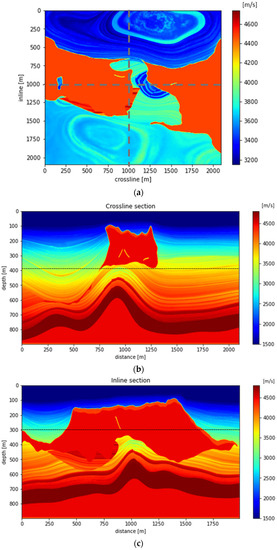
Figure 7.
The velocity model is presented in three perspectives: (a) top view with dashed line indicate the chosen inline and crossline sections, (b) crossline section, and (c) inline section. In (b,c), the black dotted line signifies the datum level, where the source and receiver are shifted from surface to virtual depth through seismic redatuming. The migration computation occurs below the datum level.
Firstly, the crossline section model as shown in Figure 7b was used to demonstrate the idea of target-oriented migration through the utilization of redatumed data. Approximately 170 sources and receivers situated on the surface were virtually relocated beneath the salt body at the depth of 380 m, marked by the black dotted line. The interval between each shot and receiver was set at 10 m. Figure 8 shows the retrieved redatumed data. The data showed good signal-to-noise ratio, despite the presence of a block of salt body within the middle of the overburden model.

Figure 8.
The redatumed shot gathers below datum level of 380 m at different are displayed for various shot locations. These redatumed data have incorporated the effect of the overburden.
Next, we defined our target area below datum level, ranging from 380 m to 600 m in depth. For this region, the travel-time for each source–receiver pair was computed using the velocity model, with consideration given to the isotropic case. Kirchhoff summation was then computed within the defined target area using Equation (2). A comparison was conducted between the migrated image obtained from the full-scale model, the target-oriented migrated image, and the convolutional model. This was carried out to showcase the benefits of the proposed workflow. The outcome is presented in Figure 9, focusing on the specific targeted depth of interest.
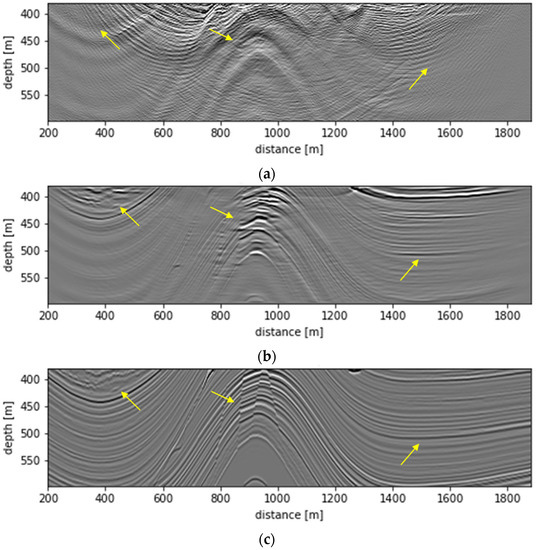
Figure 9.
The comparison between the migrated imaged from (a) the full-scale migration using surface recorded data, with a focus on the targeted depth, (b) the target-oriented migration utilizing redatumed data, and (c) the true reflectivity convolving with the wavelet, focusing on the target depth as the validation model. The results show that the migrated image utilizing redatumed data (b) contained high signal-to-noise ratio and effectively imaged the target area without being adversely affected by the salt body in the overburden. This contrasted favorably with the migrated image derived from surface data and some structures are similar to the convolutional model in (c). The yellow arrows indicate the features of the subsurface being compared.
Referring to Figure 9a, clearly the migrated image has been impacted by the salt body within the overburden. This was evidenced by the presence of strong noise in the image, which, in turn, obscured certain events within the sedimentary layers. A better migrated image was observed, as shown in Figure 9b, attributed to the prior application of seismic redatuming to the data. This enhancement led to a higher signal-to-noise ratio, consequently rendering more events visible within the image.
For the subsequent assessment, we utilized the inline cross section, as in Figure 7c, which contained a larger salt body. The sources and receivers were redatumed to a depth of 300 m, indicated by the dotted line intersecting the salt body. The aim of the second test was (1) to verify the robustness of the proposed workflow under a more complex overburden and (2) to validate its ability to compute small target areas concurrently beneath such complex overburden. For this evaluation, a total of 200 sources and receivers were utilized, spaced at intervals of 10 m.
The comparison results are presented in Figure 10, showing the contrasts between the migrated image obtained from the surface data (Figure 10a), the redatumed migrated image (Figure 10b), and the patches migrated image (Figure 10c). Due to the extensive and dominant presence of the salt body in the horizontal plane, imaging below the salt becomes challenging. As shown in Figure 10a, the imaging results exhibited limited visibility, especially along the sides of the area, and strong noise was seen within the salt body. This indicates that only a small portion of waves is effectively transmitted to deeper sections, with the majority being scattered due to the massive salt body.
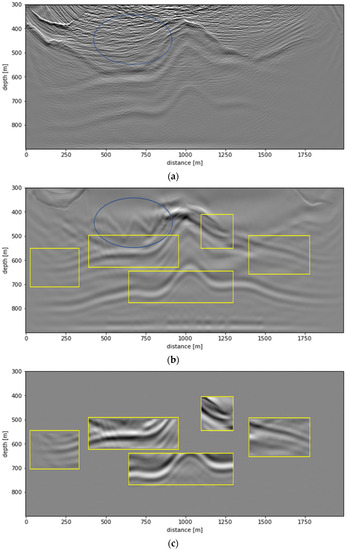
Figure 10.
The comparison between the migrated images involves (a) the full-scale migration using surface-recorded data, with focus on the targeted depth, and (b) the target-oriented migration utilizing redatumed data. The use of redatumed data leads to an improved image compared to the surface data, revealing more discernible and well-defined events (highlighted by blue circle). The migration results in (c) confirm the effectiveness of the approach to simultaneously migrate small target areas (selected as in yellow rectangles).
Through the utilization of redatumed data, an improved image was seen, shown in Figure 10b. Notably, the sharp bottom of the salt body, indicated by the blue circle, was effectively imaged. Furthermore, the imaging below the salt body’s sides was enhanced, showcasing greater visibility of events in contrast to the image showed in Figure 10a. The proposed workflow can be deemed as a more effective solution for accurately imaging the subsurface below the complex overburden.
Subsequently, we explored the feasibility of simultaneously migrating multiple smaller target areas, instead of conducting migration for the entire region below the virtual depth. This approach was considered to mitigate computational costs. The results shown in Figure 10c demonstrate the practicability of employing a patch-based migration strategy with Kirchhoff migration. We observed that the image quality remained consistent when compared to migrating the entire area beneath the datum. This consistency can be due to the utilization of the same travel-time table for both approaches. Certainly, it is interesting for future research that involves exploring the feasibility of generating travel-time tables exclusively for selected patches within the area of interest. This approach has the potential to significantly reduce the overall turnaround time for the migration process.
Finally, we evaluated the proposed workflow on East Malaysia dataset to determine its robustness towards real data. There is an extensive carbonate platform in Central Luconia area, and many carbonate build-up structures were identified. Hence, it causes poor seismic reflectivity in determining reservoir and fault mapping. Our aim was to improve the subsurface images in deeper section by leveraging seismic redatuming.
The full-scale 2D model dimensions were approximately 8 km × 6 km, comprising a total grid size of 1200 × 648. The grid intervals were set at 12.5 m × 5 m. Redatuming was performed at a depth of 650 m below the surface, generating redatumed data obtained at this virtual depth. The size of the target area spans from 650 m to 3500 m and has a grid size of 700 × 401. The grid interval was 10 m × 5 m. The total number of sources and receivers was 401, with a spacing of 20 m between each source and receiver.
The migrations were computed for both full-scale model and target-oriented model. Figure 11 presents a comparison between migration based on surface recorded data and redatumed data. Figure 11b provides a closer view of the target area, delineated by the yellow box in Figure 11a, which displays the migrated image computed from surface. The redatumed data were utilized for the migration of the target area, with the resulting image as shown in Figure 11c. The result shows that the migrated image utilizing redatumed data provided an enhanced signal-to-noise ratio and more distinct layering structure in the imaging. To validate the obtained results, we conducted a comparison of the frequency bands, as demonstrated in Figure 12. The outcome of this comparison clearly indicates that the frequency band has been improved, enabling the retrieval of higher frequencies.
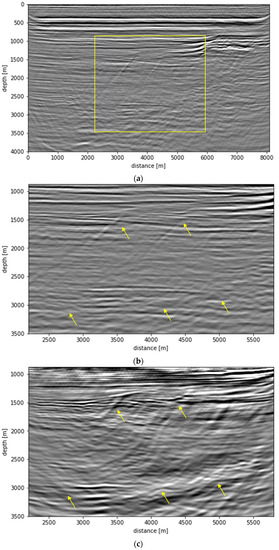
Figure 11.
The (a) full-scaled migrated image computed from surface. The yellow box delineates the target area. The (b) magnified view of the target area from (a), which then compared with the (c) migrated image obtained from redatumed data. Similar outcomes to those observed with synthetic data are evident. Improved signal-to-noise ratios and enhanced fault visibility as well as structures continuity are seen in the target-oriented migration compared to full-scale migration (highlighted by yellow arrows).
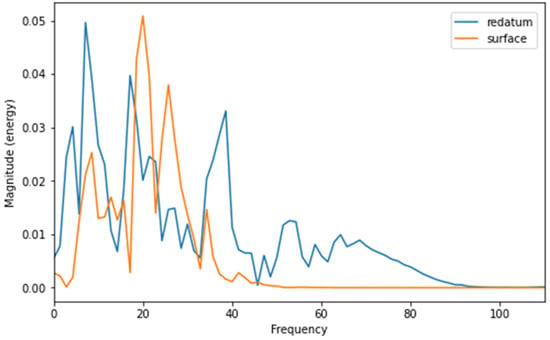
Figure 12.
A comparison of frequency band between full-scale surface image and target-oriented redatumed image. By performing seismic redatuming prior to seismic migration, the frequency band of redatumed image is enhanced. Consequently, this enhancement supports the generation of higher-quality images, as illustrated in Figure 11c compared to Figure 11b.
The quality of the migrated image utilizing redatumed data has been demonstrated to be superior to the image obtained from the observed recorded data. Additionally, we also conducted a comparison of the computational efficiency between both migration methods. As expected, the cost associated with target-oriented imaging applied to this field data was approximately 50% times lower than that of the full-scale migration. As mentioned above, the main factor contributing to the high computational cost of Kirchhoff migration is the computation of travel-time table. Since the travel-time is computed for the area below new datum level, and the target area becomes smaller, the total time required to compute the travel-time is significantly reduced and the time required for the migration of target area is also reduced. The detailed results are described in Table 1, which demonstrates that target-oriented imaging is indeed capable of expediting the seismic imaging process.

Table 1.
The comparison of computational costs between full-scale Kirchhoff migration and target-oriented Kirchhoff migration based on field dataset. The computational time is proven reduced significantly.
Our findings closely align with the results obtained by Li and Alkhalifah (2022) [42] and Guo and Alkhalifah (2020) [56]. However, their studies involved the application of redatuming for Full Waveform Inversion (FWI). In the study conducted by Li and Alkhalifah [41,42], they demonstrated the efficacy of the redatuming method in reconstructing virtual elastic data to recover impulse responses beneath a new datum. This approach led to an improved data quality beneath complex overburden. Then, they employed the redatumed data as input for elastic FWI, demonstrating its practicality and its capacity to lower computational expenses. Guo and Alkhalifah (2020) [56] also recognized the impractical costs associated with implementing FWI using a full-scale model. As a solution, they employed redatuming techniques to concentrate on velocity inversion within the target area, leading to enhanced efficiency and reduced memory requirements.
It has been proven that the proposed workflow Indeed enhanced the quality of the migrated image within the reservoir level while also leading to a substantial reduction in migration costs. However, it is important to keep in mind that the quality of the proposed method relies on the quality of the seismic redatuming method. The quality of the redatumed data can be influenced by two factors: (1) well-sampled sources and receivers and (2) the accuracy of wavelet prediction. These input factors are what affect the quality of the redatumed data. Additionally, it is important to note that the proposed workflow has solely been tested with a streamer dataset thus far. To establish its robustness and applicability, it should be subjected to testing with various acquisition datasets, including but not limited to ocean bottom cable (OBC) datasets, which encompass both PP and PS data types. We believe further research is required to come out with a detailed workflow for target-oriented migration based on seismic redatuming especially for field dataset.
4. Conclusions
To satisfy the requirements of target-oriented imaging, we proposed a workflow for target-oriented Kirchhoff migration based on a seismic redatuming method. This approach aimed to reduce both the turnaround time and the associated migration costs. The outcomes from both synthetic and field datasets affirmed the feasibility of the proposed workflow for target-oriented imaging. Its capability to generate better quality and instant migrated images within the designated region was demonstrated. Most importantly, it significantly accelerated the seismic-imaging process.
We would like to emphasize the advantages of the proposed workflow: the seismic redatuming enhanced the quality of the input gathers for Kirchhoff migration and led to the better accuracy of target-oriented Kirchhoff migration imaging below the overburden; the flexibility of the Kirchhoff algorithm was maximized by repositioning the source and receiver locations to a virtual depth for target-oriented migration, followed by the implementation of patch-based migration. Furthermore, the computational costs in computing the travel-time for Kirchhoff migration was reduced significantly by focusing on the targeted area compared to the conventional full-scale migration.
Moreover, there are many opportunities for further exploration of this methodology, particularly in the realms of reservoir characterization and seismic inversion. The present study focused solely on assessing the kinematic accuracy of the proposed target-oriented migration, without addressing the amplitude accuracy of the migrated data. Therefore, this study can be expanded to evaluate the dynamic accuracy of the proposed target-oriented migration method, with the aim of achieving true-amplitude target-oriented migration.
Author Contributions
Conceptualization, F.S.D. and H.R.; methodology, F.S.D. and H.S.H.; validation, F.S.D.; formal analysis, F.S.D. and H.S.H.; investigation, F.S.D.; data curation, F.S.D., H.S.H. and A.M.M.; writing—original draft preparation, F.S.D.; writing—review and editing, A.H.A.L., H.R. and J.L.; supervision, A.H.A.L. and H.R.; project administration, A.H.A.L. and H.R.; All authors have read and agreed to the published version of the manuscript.
Funding
The work is supported by PETRONAS Research Sdn Bhd and Universiti Teknologi PETRONAS under grant 015LC0-309.
Institutional Review Board Statement
Not applicable.
Informed Consent Statement
Not applicable.
Data Availability Statement
Not applicable.
Acknowledgments
I would like to express my special thanks of gratitude to Daniel Trad from the University of Calgary, Eric Verschuur from TU Delft, and Umair bin Waheed from King Fahd University of Petroleum and Minerals, who helped me during the conceptual understanding, providing extraordinary cooperation and invaluable guidance.
Conflicts of Interest
The authors declare no conflict of interest.
References
- Jones, I. A practical review of migration issues and solutions. In Proceedings of the First EAGE West Africa Workshop 2013-Subsurface Challenges in West Africa, London, UK, 7–8 November 2013; European Association of Geoscientists & Engineers: Utrecht, The Netherlands, 2013; p. cp-364. [Google Scholar]
- Al-Duri, S.A.S.; Abbas, A.H. Comparing between KM and RTM Algorithms to Pre-Stack Migrate Seismic Data. IOP Conf. Ser. Mater. Sci. Eng. 2020, 928, 032049. [Google Scholar] [CrossRef]
- Hatton, L.; Larner, K.; Gibson, B.S. Migration of seismic data from inhomogeneous media. Geophysics 1981, 46, 751–767. [Google Scholar] [CrossRef]
- Lines, L.; Burton, A.; Lu, X. Migration without migraines. In SEG Technical Program Expanded Abstract 1994; Society of Exploration Geophysicists: Houston, TX, USA, 1994; pp. 1236–1241. [Google Scholar]
- Gray, S.H.; Etgen, J.; Dellinger, J.; Whitmore, D. Seismic migration problems and solutions. Geophysics 2001, 66, 1622–1640. [Google Scholar] [CrossRef]
- Wu, W.J. The advantage and significance of prestack migration. In SEG Technical Program Expanded Abstracts 2001; Society of Exploration Geophysicists: Houston, TX, USA, 2001; pp. 1037–1040. [Google Scholar]
- Tygel, M.; Santos, L.T.; Schleicher, J.; Hubral, P. Kirchhoff imaging as a tool for AVO/AVA analysis. Lead. Edge 1999, 18, 940–945. [Google Scholar] [CrossRef]
- Whiting, P.; Notfors, C.; Zhan, Y.; Gray, S. Prestack Kirchhoff migration and amplitude accuracy. ASEG Ext. Abstr. 2001, 2001, 1–4. [Google Scholar] [CrossRef]
- Xavier, M.; Portugal, R.S. AVO Analysis in Real Pre-Stack Seismic Data: A Powerful Tool for Fluid Identification During Petroleum Exploration. In Proceedings of the 16th International Congress of the Brazilian Geophysical Society, Rio de Janeiro, Brazil, 19–22 August 2019. [Google Scholar]
- Costa, F.; Capuzzo, F.; de Souza, A., Jr.; Moreira, R.; Lopez, J.; Cetale, M. Understanding refracted wave paths for Brazilian pre-salt target-oriented imaging. In SEG Technical Program Expanded Abstracts 2020; Society of Exploration Geophysicist: Houston, TX, USA, 2020; pp. 2375–2380. [Google Scholar]
- Kumar, R.; Graff, M.; Vasconcelos, I.; Herrmann, F.J. Target-oriented imaging using extended image volumes: A low-rank factorization approach. Geophys. Prospect. 2019, 67, 1312–1328. [Google Scholar] [CrossRef]
- Liu, H.; Al-Ali, M.N. Common-focus point-based target-oriented imaging approach for continuous seismic reservoir monitoring. Geophysics 2018, 83, M41–M48. [Google Scholar] [CrossRef]
- Jiang, Z.; Schuster, G.T. Target-oriented least squares migration. In 2003 SEG Annual Meeting; OnePetro: Richardson, TX, USA, 2003. [Google Scholar]
- Luo, Y.; Schuster, G.T. Bottom-up target-oriented reverse-time datuming: C.P.S. In SEG Geophysics Conference and Exhibition F; SEG: Houston, TX, USA, 2004; Volume 55. [Google Scholar]
- Dong, S.; Xiao, X.; Schuster, G.T. 3D target-oriented reverse-time datuming. In 77th Annual International Meeting, SEG, Expanded Abstracts; SEG: Houston, TX, USA, 2007; pp. 2442–2445. [Google Scholar]
- Zhang, R.; Huang, J.P.; Zhuang, S.B.; Li, Z.C. Target-oriented Gaussian beam migration using a modified ray tracing scheme. Pet. Sci. 2019, 16, 1301–1319. [Google Scholar] [CrossRef]
- Barbosa, W.A.; da Silva, S.L.E.; de la Barra, E.; de Araújo, J.M. Full-waveform inversion based on generalized Rényi entropy using patched Green’s function techniques. PLoS ONE 2022, 17, e0275416. [Google Scholar] [CrossRef]
- Trad, D. Least squares Kirchhoff depth migration: Implementation, challenges, and opportunities. In SEG Technical Program Expanded Abstracts 2015; Society of Exploration Geophysicists: Houston, TX, USA, 2015; pp. 4238–4242. [Google Scholar]
- Trad, D. Challenges for least-squares Kirchhoff depth migration. In SEG Technical Program Expanded Abstracts 2017; Society of Exploration Geophysicists: Houston, TX, USA, 2017; pp. 4545–4549. [Google Scholar]
- Trad, D. Least squares Kirchhoff depth migration: Important details. In Proceedings of the Geo-convention, Calgary, AB, Canada, 15–19 May 2017. [Google Scholar]
- Casasanta, L.; Perrone, F.; Roberts, G.; Ratcliffe, A.; Purcell, K.; Jafargandomi, A.; Poole, G. Applications of single-iteration Kirchhoff least-squares migration. In SEG Technical Program Expanded Abstracts 2017; Society of Exploration Geophysicists: Houston, TX, USA, 2017; pp. 4432–4437. [Google Scholar]
- Casasanta, L.; Roberts, G.; Perrone, F.; Ratcliffe, A.; Poole, G.; Wang, Y.; Xie, Y. Practical benefits of Kirchhoff least-squares migration deconvolution. In Proceedings of the 79th EAGE Conference and Exhibition 2017, Paris, France, 12–15 June 2017; European Association of Geoscientists & Engineers: Utrecht, The Netherlands, 2017; Volume 2017, pp. 1–5. [Google Scholar]
- Znak, P.; Troyan, V. 3-D Kirchhoff migration weights to separate point and edge diffraction. In Proceedings of the 83rd EAGE Annual Conference & Exhibition, Madrid, Spain, 6–9 June 2022; European Association of Geoscientists & Engineers: Utrecht, The Netherlands, 2022; Volume 2022, pp. 1–5. [Google Scholar]
- Zhang, Y.; Gray, S.; Young, J. Exact and approximate weights for Kirchhoff migration. In SEG International Exposition and Annual Meeting; SEG: Houston, TX, USA, 2000; p. SEG-2000. [Google Scholar]
- Gray, S.H.; May, W.P. Kirchhoff migration using eikonal equation traveltimes. Geophysics 1994, 59, 810–817. [Google Scholar] [CrossRef]
- Ghazali, A.R.; Verschuur, D.J.; Gisolf, A. Seismic imaging through gas clouds: A data driven imaging strategy. In Proceedings of the SEG Technical Program, Expanded Abstracts, Las Vegas, NV, USA, 9–14 November 2008; Volume 2302–2306. [Google Scholar]
- Lu, R.; Willis, M.; Campman, X.; Ajo-Franklin, J.; Toksöz, M.N. Redatuming through a salt canopy and target-oriented salt-flank imaging. Geophysics 2008, 73, S63–S71. [Google Scholar] [CrossRef]
- Berryhill, J.R. Wave-equation datuming. Geophysics 1979, 44, 1329–1344. [Google Scholar] [CrossRef]
- da Rocha, T.C.; Garabito, G.; Hubral, P.; Shahsavani, H.; Gonçalves, B.F. Sensitivity analysis to near-surface velocity errors of the Kirchhoff single-stack redatuming of multi-coverage seismic data. J. Appl. Geophys. 2022, 206, 104788. [Google Scholar] [CrossRef]
- Ghazali, A.R. True-Amplitude Seismic Imaging Beneath Gas Clouds. Ph.D. Thesis, TU Delft, Delft, The Netherlands, 2011. [Google Scholar]
- Rahim, M.A.; Ulugergerli, E.U.; Konuk, T.; Ghazali, A.R. Characterization of Gas Clouds Using Non-linear Full Waveform Inversion. In Proceedings of the EAGE Workshop on Seismic Attenuation, Singapore, 28–30 October 2013; European Association of Geoscientists & Engineers: Utrecht, The Netherlands, 2013; p. cp-363. [Google Scholar]
- Zahir, M.; Hafizal, M.; Md Sahad, S.; Ishak, M.A.; Ghazali, A.R. Application of Full Wavefield Migration in Obtaining True Amplitude Below Gas Cloud. In Proceedings of the International Petroleum Technology Conference, Beijing, China, 26–28 March 2019. [Google Scholar]
- Marchenko, V.A. On reconstruction of the potential energy from phases of the scattered waves. Dokl. Akad. Nauk SSSR 1955, 104, 695–698. [Google Scholar]
- Ravasi, M.I.; Vasconcelos, A.; Kritski, A.; Curtis, A.; da Costa Filho, C.A.; Meles, G.A. Target-oriented Marchenko imaging of a North Sea field. Geophys. J. Int. 2016, 205, 99–104. [Google Scholar] [CrossRef]
- Cui, T.; Becker, T.S.; van Manen, D.J.; Rickett, J.E.; Vasconcelos, I. Marchenko redatuming in a dissipative medium: Numerical and experimental implementation. Phys. Rev. Appl. 2018, 10, 044022. [Google Scholar] [CrossRef]
- Wapenaar, K.; Brackenhoff, J.; Dukalski, M.; Meles, G.; Reinicke, C.; Slob, E.; Staring, M.; Thorbecke, J.; van der Neut, J.; Zhang, L. Marchenko redatuming, imaging, and multiple elimination and their mutual relations. Geophysics 2021, 86, WC117–WC140. [Google Scholar] [CrossRef]
- Li, Y.; Guo, Q.; Alkhalifah, T.; Kazei, V. Target-oriented time-lapse waveform inversion using redatumed data: Feasibility and robustness. In SEG Technical Program Expanded Abstracts 2020; Society of Exploration Geophysicists: Houston, TX, USA, 2020; pp. 3783–3787. [Google Scholar]
- Li, Y.; Alkhalifah, T.; Guo, Q. Target-oriented time-lapse waveform inversion using deep learning-assisted regularization. Geophysics 2021, 86, R485–R495. [Google Scholar] [CrossRef]
- Guo, Q.; Alkhalifah, T. Waveform inversion-based target-oriented redatuming. In SEG Technical Program Expanded Abstracts 2018; Society of Exploration Geophysicists: Houston, TX, USA, 2018; pp. 1233–1237. [Google Scholar]
- Guo, Q.; Alkhalifah, T. Datum-based waveform inversion using a subsurface-scattering imaging condition. Geophysics 2019, 84, S251–S266. [Google Scholar] [CrossRef]
- Biondi, E.; Barnier, G.; Biondi, B.; Clapp, R.G. Target-oriented elastic full-waveform inversion through acoustic extended image-space redatuming. Geophysics 2023, 88, R269–R296. [Google Scholar] [CrossRef]
- Li, Y.; Alkhalifah, T. Target-oriented high-resolution elastic full-waveform inversion with an elastic redatuming method. Geophysics 2022, 87, R379–R389. [Google Scholar] [CrossRef]
- Garg, A.; Verschuur, D.J. From surface seismic data to reservoir elastic parameters using a full-wavefield redatuming approach. Geophys. J. Int. 2020, 221, 115–128. [Google Scholar] [CrossRef]
- Dondurur, D. Acquisition and Processing of Marine Seismic Data; Elsevier: Amsterdam, The Netherlands, 2018. [Google Scholar]
- Fang, K. Prestack Kirchhoff Migration; Research Report; CREWES: Crewe, UK, 1995; Volume 7. [Google Scholar]
- Sinha, D.P.; Vishnoi, D.K.; Basu, S.; Singh, V.P. A Brief Comparison of the Efficacy of Four Migration Algorithms—A Sub-Basalt Example Geohorizons; S.P.G.: New Delhi, India, 2009; pp. 24–27. [Google Scholar]
- Yousefzadeh, A.; Bancroft, J.C. Writing Kirchhoff Migration/Modelling in a Matrix Form; Annual Research Report; CREWES: Crewe, UK, 2011; Volume 23. [Google Scholar]
- Jain, R. Kirchhoff Pre-Stack Depth Migration: Effective tool for depth imaging. In Proceedings of the 9th Biennial International Conference & Exposition on Petroleum Geophysiscs, Hyderabad, India, 16–18 February 2012. [Google Scholar]
- Hertweck, T.; Jäger, C. Short note: Various aspects of Kirchhoff migration. Annu. WIT Rep. 2002, 133–142. Available online: https://www.wit.uni-hamburg.de/import/documents/reports/2002/wit2002-hertweck.pdf (accessed on 13 July 2023).
- Schneider, W.A. Integral formulation for migration in two and three dimensions. Geophysics 1978, 43, 49–76. [Google Scholar] [CrossRef]
- Hagedoorn, J.G. A process of seismic reflection interpretation. Geophys. Prospect. 1954, 2, 85–127. [Google Scholar] [CrossRef]
- Zhao, H. A fast-sweeping method for eikonal equations. Math. Comput. 2005, 74, 603–628. [Google Scholar] [CrossRef]
- Waheed, U.B.; Yarman, C.E.; Flagg, G. An iterative, fast-sweeping-based eikonal solver for 3D tilted anisotropic media. Geophysics 2015, 80, C49–C58. [Google Scholar] [CrossRef]
- Waheed, U.B.; Alkhalifah, T. A fast-sweeping algorithm for accurate solution of the tilted transversely isotropic eikonal equation using factorization. Geophysics 2017, 82, WB1–WB8. [Google Scholar] [CrossRef]
- Waheed, U.B. A fast-marching eikonal solver for tilted transversely isotropic media. Geophysics 2020, 85, S385–S393. [Google Scholar] [CrossRef]
- Guo, Q.; Alkhalifah, T. Target-oriented waveform redatuming and high-resolution inversion: Role of the overburden. Geophysics 2020, 85, R525–R536. [Google Scholar] [CrossRef]
Disclaimer/Publisher’s Note: The statements, opinions and data contained in all publications are solely those of the individual author(s) and contributor(s) and not of MDPI and/or the editor(s). MDPI and/or the editor(s) disclaim responsibility for any injury to people or property resulting from any ideas, methods, instructions or products referred to in the content. |
© 2023 by the authors. Licensee MDPI, Basel, Switzerland. This article is an open access article distributed under the terms and conditions of the Creative Commons Attribution (CC BY) license (https://creativecommons.org/licenses/by/4.0/).